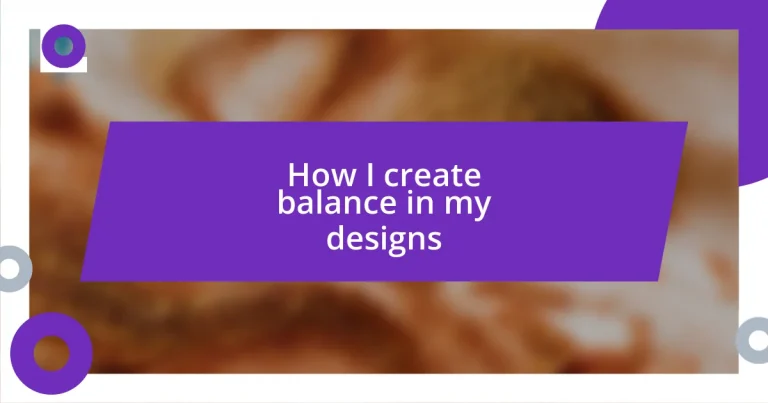Key takeaways:
- Understanding balance in design involves recognizing visual weight and the interplay of elements, allowing for emotional connections with viewers.
- Techniques such as radial balance, color harmony, and visual hierarchy are essential for creating engaging and well-structured designs.
- Feedback from peers and clients is crucial for evaluating and adjusting designs, leading to improved clarity, effectiveness, and emotional resonance.

Understanding design balance principles
When I think about design balance principles, I often relate it to the feeling I get when observing a perfectly balanced scene, like a serene landscape or an artfully arranged living space. It’s about achieving visual harmony, a state where no single element overwhelms the others. Have you ever noticed how your eyes naturally glide over a well-balanced design, feeling almost at ease?
The two main types of balance—symmetrical and asymmetrical—each evoke distinct emotions. Symmetrical designs offer a sense of order and calm, while asymmetrical ones can create excitement and movement. I remember trying my hand at an asymmetrical layout for a project; the initial chaos felt unnerving, yet as I adjusted the elements, I realized it mimicked the dynamic flow of life itself. It’s fascinating how balance doesn’t mean everything has to match; sometimes, the tension between different elements can lead to a richer experience.
One principle I often rely on is the idea of visual weight—how some pieces draw the eye more than others. A bold color or a large shape can anchor a design, while lighter elements can be used to create a sense of space. I recall a particular instance where I used a hefty, dark piece to ground an airy composition. Watching others react to that contrast was a revelation, reinforcing my belief that balance, far from being static, invites interaction and breathing room in a design.

Identifying balance in design elements
Identifying balance in design elements is an intuitive process that relies heavily on observing how different components interact with one another. I often ask myself, “Which element feels heavier in this composition?” For instance, in a recent project, I had a striking image on one side and a delicate text block on the other. At first, it felt lopsided, but when I adjusted the spacing and resized the text, the piece found its equilibrium. It was a reminder that balance often requires thoughtful tweaking rather than rigid rules.
- Visual Weight: Consider how colors and sizes affect perception; a vibrant red will draw eyes more than a pastel hue.
- Proximity: Grouping elements closely can create a feeling of unity, while spacing can evoke tension or separation.
- Contrast: Using differing shapes or textures can enhance interest and guide viewers’ attention to focal points.
- Movement: Think about the eye’s path; frequently, I find the balance between static and dynamic elements creates a compelling flow.
In another instance, while designing a brochure, I realized that the white space I initially viewed as empty actually provided a necessary counterbalance. It made the vibrant images pop and allowed the text to breathe, revealing how sometimes less truly becomes more. Balancing design elements isn’t just about visual appeal—it’s about fostering an emotional connection with the viewer.

Techniques for achieving visual balance
When I explore techniques for achieving visual balance in my designs, I often gravitate towards the principle of radial balance. It’s curious how a design can feel both harmonious and dynamic when the elements radiate from a central point. I once experimented with this technique in a poster project for a local event, arranging typography around a central image. The result was exhilarating; it not only drew the viewer’s eye in but also created a sense of movement toward the focal point, leaving a lasting impression.
Another powerful technique I frequently utilize involves the deliberate use of color harmony. I personally find that creating a cohesive color palette can unify disparate elements, providing a strong sense of stability. In one design, I chose a cool blue tone to bring together contrasting bright elements. This choice not only provided a soothing backdrop but also allowed each individual piece to shine while maintaining a cohesive overall feel. Color, for me, becomes a thread that ties together the visual story I’m telling.
Lastly, I champion the effective use of visual hierarchy. By prioritizing certain elements over others through size, contrast, or placement, I can control the viewer’s path through the design. For example, in a website layout I worked on, placing an important call-to-action button at the bottom of the page but making it significantly larger drew immediate attention, creating a natural flow from one section to the next. This technique emphasizes how thoughtful placement can guide viewers, making their experience not just visually balanced, but also intuitively engaging.
| Technique | Description |
|---|---|
| Radial Balance | Elements radiate from a central point, creating dynamic harmony. |
| Color Harmony | Cohesive color palettes unify various design elements for stability. |
| Visual Hierarchy | Prioritization through size and contrast to guide viewer attention. |

Importance of color in balance
When I dive into the world of color, I’m constantly amazed by its transformative power in achieving balance. For instance, I once worked on a project where I used a deep teal juxtaposed against warm coral. The contrast not only created visual excitement but also established a sense of equilibrium. Have you ever noticed how certain colors just feel right together? It’s all about how they interact and support each other within the composition.
Color also plays a pivotal role in guiding emotion and creating a sense of harmony. I remember designing a page where the main background was a soft beige, allowing vivid illustrations to capture attention without overwhelming the senses. This delicate balance generates an inviting atmosphere, encouraging the viewer to linger. Don’t you agree that a palette can evoke specific feelings? It fascinates me how the right colors can provoke curiosity, calm, or even nostalgia.
The concept of visual weight in color also intrigues me. Why is it that a bright yellow pops out more dramatically than an earthy green? I recall a workspace redesign where I strategically placed bold accents of orange on a muted palette. The bright pops kept the energy alive, making the space feel both vibrant and well-composed. This balance elevates the design, drawing the viewer’s eye to what matters while maintaining overall harmony. How do you use color to achieve balance in your own work? It’s a question worth exploring, as it can transform a chaotic layout into a beautifully orchestrated visual narrative.

Using typography for balanced designs
Using typography effectively is essential for achieving balanced designs. When I design, I often play with font weight and size, as these elements help create a visual flow that guides the viewer’s gaze. For instance, in a recent branding project, I paired a bold sans-serif font with an elegant script typeface. The contrast between the two not only established a hierarchy but also added a touch of personality that reflected the brand’s identity.
I’ve also found that line spacing can make a significant difference in how a design feels. In one of my layouts, experimenting with increased line height created a sense of breathing room around the text, making it more readable and visually appealing. It’s intriguing how something as simple as spacing can transform the viewer’s experience, right? By allowing the elements to “breathe,” I foster a calming effect that prevents the design from feeling cramped or overwhelming.
Another aspect I pay close attention to is the alignment of text elements. I’ve learned that a well-aligned layout can create a sense of order and stability. In a newsletter I crafted, ensuring that all headings were left-aligned while body text was justified created a clean and organized appearance. When you achieve this level of balance, it feels rewarding, enhancing not only visual appeal but also the clarity of the message being conveyed. How do you approach typography in your designs? It’s an exploration that repeatedly leads to delightful discoveries for me.

Evaluating balance through feedback
Evaluating balance through feedback is a vital part of my design process. I remember sharing a project with peers and receiving unexpected critiques that truly opened my eyes. One designer pointed out that while I loved the color scheme, the element placement felt a bit off-balance. It was an enlightening moment that reinforced the idea that fresh perspectives can help recalibrate my vision.
I often turn to client feedback as a compass for balance. There was a time when a client expressed confusion over the visual hierarchy I had set, which pushed me to reassess how elements interacted on the page. After making adjustments based on their input, the design not only became clearer but also more engaging. It’s fascinating how constructive criticism can enhance both a design’s balance and its overall effectiveness.
Moreover, I find that feedback goes beyond the technical aspects; it also taps into emotional responses. In one instance, I presented a layout that I believed was perfectly balanced, only to see the client’s eyes glaze over. This prompted me to ask for specific feelings they aimed to evoke. Once we aligned on that emotional goal, the design transformed into something dynamic and meaningful. Isn’t it amazing how understanding emotions can drive you toward balance? Engaging with feedback in this way transforms the design experience into a collaborative journey, refining my work and fostering connection.

Adjusting designs for optimal balance
Adjusting designs for optimal balance often requires a keen eye for small details. I’ve found that tweaking the scale of various elements can drastically alter the overall harmony of a piece. For example, I once adjusted the size of an image in a promotional poster; making it slightly larger drew attention without overshadowing the accompanying text, resulting in a more harmonious layout. Isn’t it fascinating how minor adjustments can reshape the viewer’s experience entirely?
In my experience, color plays a pivotal role in achieving balance, too. I remember a project where I used an overwhelming number of bright colors, thinking it would create excitement. However, the outcome felt chaotic. After some reflection, I simplified the palette to include softer tones that complemented one another, which transformed the design into something inviting and serene. Have you ever had a similar epiphany where less truly became more?
Furthermore, incorporating negative space can be a game-changer in achieving design equilibrium. When I was working on a website layout, I noticed the content felt cramped. I decided to expand the margins and introduce more white space around key elements, which allowed the design to breathe, creating clarity and focus. I could almost feel the tension dissipate as the layout opened up. It’s like the design found its voice! How do you approach the use of space in your work? Adjusting these crucial elements is an ongoing practice that continuously enhances my design journey.














